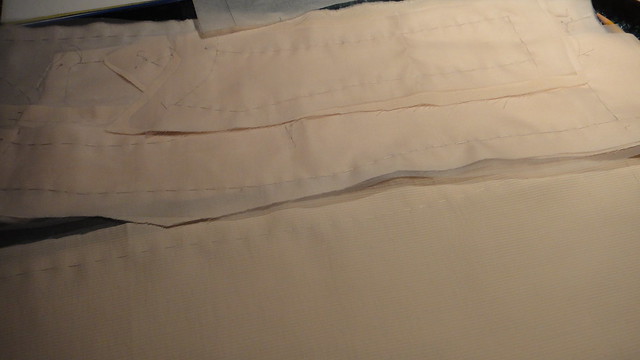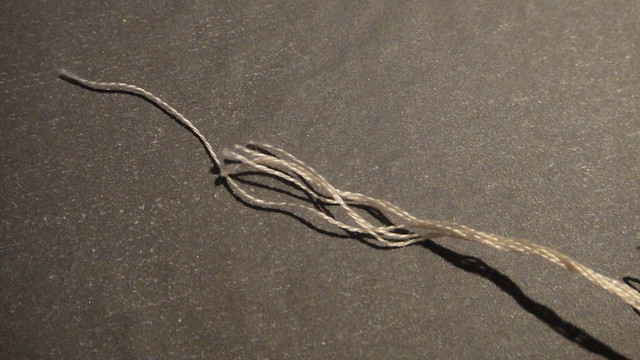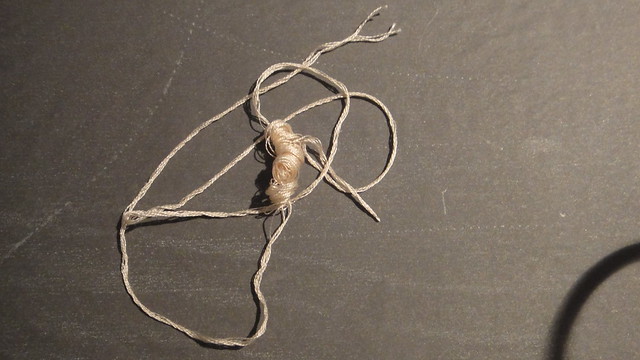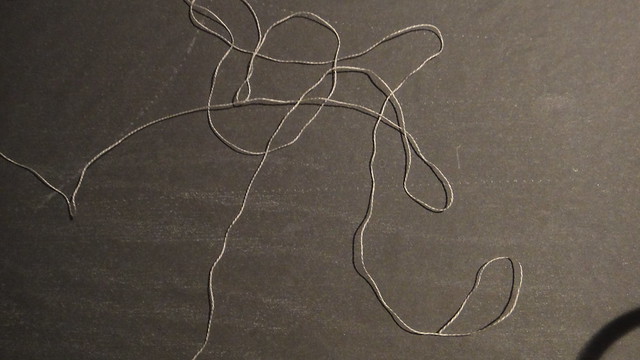Thread tracing - What color to use?
Ok so we've already established that using dark marks on white organza when attaching it to light transparent fabrics is probably not a great idea. You could maybe get away with using it only on the seam lines, and not for marking the grain lines on the center of the patterns, another risk is exposing the seam line markings if you need to let seams out in the final fitting. After trying chemicals, and the ironing on brown paper to absorb the wax, the markings remained. So choose carefully.
On to Thread Tracing
(ahhh doesn't that look better? The organza has been recut)

You'll be happy to hear the thread tracing is finished on the body, tomorrow I'll tackle the sleeves, so here's what we've learned....
Using highly contrasting thread on your thread tracing probably also a no no. I had to recut one side panel to make the side seam adjustment and pulled out all of the thread tracing. What was left behind was a very light blue line making it look dirty from the right side. You can see it here.

The Japanese basting thread has short fibers (which is a good property for thread tracing). It grips the fabric in a way that regular sewing thread does not. Choose a color closer to the fashion fabric, and if you can't find any....
What can you use to substitute?
How about some DMC cotton embroidery floss, and I just happen to have some in a perfect color for this project.

If you've never used this before, follow these instructions. Embroidery floss is really 6 twisted threads in one strand.

When you use it for embroidery, you select the number of threads you want to use and pull them out one by one. For thread tracing, cut the strand the length you want to use, and separate the threads.

Pull one thread and hold the end of the strand (make sure it's only one thread you're holding onto). It should come out easily enough, you'll be left with a curly 5 thread strand, but you can find the end and straighten the remaining strand out.

You'll repeat this for every thread you need, just find one thread end hold the opposite end in the other hand and pull that one out of the pack. Or if you want to be like Martha Stewart you can go to the DMC-USA website for neat illustrations on how to separate the strands properly :) (we love Martha).

What's nice about it is that it's readily available, you are bound to get a better color match, or coordinated color, you don't need a special needle for it, it goes a long way and it's not expensive.
On to Thread Tracing
(ahhh doesn't that look better? The organza has been recut)

You'll be happy to hear the thread tracing is finished on the body, tomorrow I'll tackle the sleeves, so here's what we've learned....
Using highly contrasting thread on your thread tracing probably also a no no. I had to recut one side panel to make the side seam adjustment and pulled out all of the thread tracing. What was left behind was a very light blue line making it look dirty from the right side. You can see it here.

The Japanese basting thread has short fibers (which is a good property for thread tracing). It grips the fabric in a way that regular sewing thread does not. Choose a color closer to the fashion fabric, and if you can't find any....
What can you use to substitute?
How about some DMC cotton embroidery floss, and I just happen to have some in a perfect color for this project.

If you've never used this before, follow these instructions. Embroidery floss is really 6 twisted threads in one strand.

When you use it for embroidery, you select the number of threads you want to use and pull them out one by one. For thread tracing, cut the strand the length you want to use, and separate the threads.

Pull one thread and hold the end of the strand (make sure it's only one thread you're holding onto). It should come out easily enough, you'll be left with a curly 5 thread strand, but you can find the end and straighten the remaining strand out.

You'll repeat this for every thread you need, just find one thread end hold the opposite end in the other hand and pull that one out of the pack. Or if you want to be like Martha Stewart you can go to the DMC-USA website for neat illustrations on how to separate the strands properly :) (we love Martha).

What's nice about it is that it's readily available, you are bound to get a better color match, or coordinated color, you don't need a special needle for it, it goes a long way and it's not expensive.

Comments